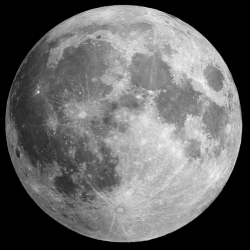
There are many conflicting studies about the Moon’s origins. It’s astonishing how little concrete information we have about how the Moon was formed. But a new study could clear up some confusion around the Moon’s infancy by searching for answers in a seriously unorthodox way, with nuclear fallout.
A team of researchers at Scripps Institution of Oceanography at the University of California San Diego has examined the composition of trinite glass at the Trinity test site in New Mexico — where the first plutonium bomb was detonated in 1945, for parallels between chemical reactions in this material and in lunar samples. After examining trinite collected between 30 and 800 feet from ground zero, the team confirmed key similarities in chemical processes between the samples collected at the site, and those in previously-studied lunar rocks. The group’s findings were published today in Science Advances.
“[Trinity] has good samples for many reasons,” Professor James Day, who led the study, told Gizmodo. “The first thing is the geology of the site, which is arkosic sandstone, and of course, quartz, which can evaporate, but it can also melt.” While it’s unusual to think about rocks evaporating, the silicate minerals in quartz can in fact vaporise under extremely high temperatures, like those that occur during a giant impact, or a nuclear blast.
Day explained that the team was specifically analysing volatile elements that evaporate at high temperatures in Trinity rocks, and comparing the data with lunar sample measurements. The rock samples recovered closer to ground zero were “dried out” with respect to certain of these elements, including zinc. This wasn’t the case with samples collected farther away from the detonation area, since those samples weren’t exposed to such high levels of heat.
“To ‘dry out’ a body the size of the moon, you need a lot of heat and it needs to be very very big process,” Day said. “So the argument we put forward is this happened during the formation of the moon, probably during a giant impact, because you need something very violent and very large to cause this complete melting and drying of the moon.”
He continued: “By using the Trinity test samples, we were able to show that indeed this process occurs. We can look at these Trinity samples and look at the drying out of the samples. What we find is they almost exactly mimic what we see for lunar samples.”
The concept of the “giant impact theory,” in which a protoplanet collided with Earth and formed the Moon, has been widely discussed since the 1970s. In addition to being downright cool that we can find evidence to support that theory in nuclear test explosions, better understanding volatile elements may help us unlock other mysteries right here on Earth.
“There’s so many next steps, because our understanding of volatiles is so important,” Day said. “One of the things we really need to address is why do we have water on the Earth, why do we have lots of volatiles, why is [our planet] habitable? We really don’t know all the answers to this, but we’re beginning to scratch the surface.”
